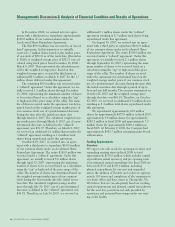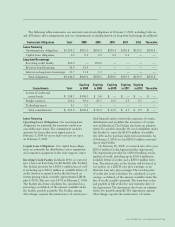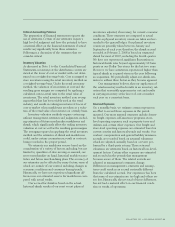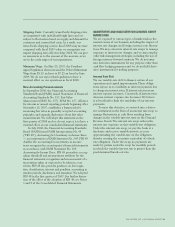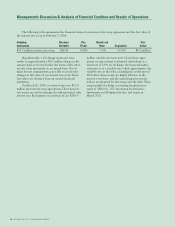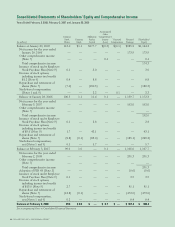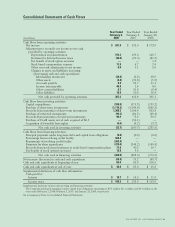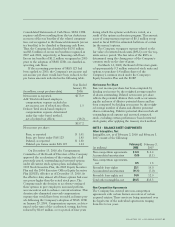Dollar Tree 2007 Annual Report Download - page 27
Download and view the complete annual report
Please find page 27 of the 2007 Dollar Tree annual report below. You can navigate through the pages in the report by either clicking on the pages listed below, or by using the keyword search tool below to find specific information within the annual report.
DOLLAR TREE, INC. • 2007 ANNUAL REPORT
25
Shipping Costs. Currently, trans-Pacific shipping rates
are negotiated with individual freight lines and are
subject to fluctuation based on supply and demand for
containers and current fuel costs. As a result, our
trans-Pacific shipping costs in fiscal 2008 may increase
compared with fiscal 2007 when we renegotiate our
import shipping rates effective May 2008. We can give
no assurances as to the amount of the increase, as we
are in the early stages of our negotiations.
Minimum Wage. On May 25, 2007, the President
signed legislation that increased the Federal Minimum
Wage from $5.15 an hour to $7.25 an hour by June
2009. We do not expect this legislation to have a
material effect on our operations in fiscal 2008.
New Accounting Pronouncements
In September 2006, the Financial Accounting
Standards Board (FASB) issued Statement of Financial
Accounting Standards No. 157, Fair Value
Measurement (SFAS No. 157). SFAS No. 157, effective
for interim or annual reporting periods beginning after
November 15, 2007, establishes a framework for
measuring fair value in generally accepted accounting
principles and expands disclosures about fair value
measurements. We will adopt this statement in the
first quarter of 2008 and we do not expect it to have a
material effect on our consolidated financial statements.
In July 2006, the Financial Accounting Standards
Board (FASB) issued FASB Interpretation No. 48
(“FIN 48”), Accounting for Uncertainty in Income Taxes
— an interpretation of FASB Statement No. 109. FIN 48
clarifies the accounting for uncertainty in income
taxes recognized in an enterprise’s financial statements
in accordance with FASB Statement No. 109,
Accounting for Income Taxes. FIN 48 prescribes a recog-
nition threshold and measurement attribute for the
financial statement recognition and measurement of a
tax position taken or expected to be taken in a tax
return. FIN 48 also provides guidance on derecogni-
tion, classification, interest and penalties, accounting in
interim periods, disclosures, and transition. We adopted
FIN 48 in the first quarter of 2007. For further discus-
sion of the effect of the adoption of FIN 48, see Notes
1 and 3 of the Consolidated Financial Statements.
QUANTITATIVE AND QUALITATIVE DISCLOSURES ABOUT
MARKET RISK
We are exposed to various types of market risk in the
normal course of our business, including the impact of
interest rate changes and foreign currency rate fluctua-
tions. We may enter into interest rate swaps to manage
exposure to interest rate changes, and we may employ
other risk management strategies, including the use of
foreign currency forward contracts. We do not enter
into derivative instruments for any purpose other than
cash flow hedging purposes and we do not hold deriv-
ative instruments for trading purposes.
Interest Rate Risk
We use variable-rate debt to finance certain of our
operations and capital improvements. These obliga-
tions expose us to variability in interest payments due
to changes in interest rates. If interest rates increase,
interest expense increases. Conversely, if interest rates
decrease, interest expense also decreases. We believe
it is beneficial to limit the variability of our interest
payments.
To meet this objective, we entered into a deriva-
tive instrument in the form of an interest rate swap to
manage fluctuations in cash flows resulting from
changes in the variable-interest rates on the Demand
Revenue Bonds. The interest rate swap reduces the
interest rate exposure on this variable-rate obligation.
Under the interest rate swap, we pay the bank at a
fixed-rate and receive variable-interest at a rate
approximating the variable-rate on the obligation,
thereby creating the economic equivalent of a fixed-
rate obligation. Under the swap, no payments are
made by parties under the swap for monthly periods
in which the variable-interest rate is greater than the
predetermined knock-out rate.







